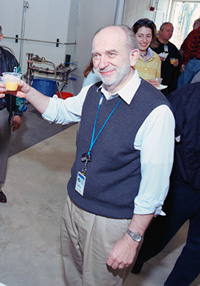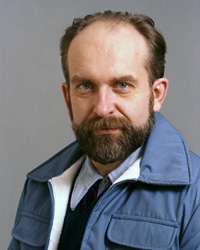Ray Stefanski retires after 41 years
|
 |
| Fermilab scientist Ray Stefanski, who was integral to the design and construction of the MiniBooNE experiment, celebrates the completion of construction in 2002. |
It was late summer of 1969 when Ray Stefanski drove his Sunbeam Alpine from Brookhaven to Fermilab. The coupe allowed him a great view as he drove past the Fermilab landscape.
"I thought, this could be a good place to stay for a few years, and then I'll get myself a real job," Stefanski said.
But he was attracted to the intellectually adventurist spirit of the laboratory and its founding director, Robert Wilson, and the physicist found himself pursuing exciting project after project. Now, more than 41 years later, Stefanski has gone to look for adventure elsewhere. He retired in December.
"Bob Wilson encouraged us to explore crazy ideas," Stefanski said. "He was our inspiration to try new things all the time and he really stood up for what he believed in."
Stefanski has tried to model Wilson's approach in his career.
"In the 1970s, Ray was Mr. Neutrino," said scientist Herman White. "He was undaunted by any project that needed to be done and we were doing things that had never been done before."
Stefanski initially worked as part of the Neutrino Department in the original Research Division on the design and construction of the Neutrino Area. He then participated in several neutrino experiments and helped to design and build neutrino beams.
In 1974, Stefanski, White's first supervisor, was part of a team trying to provide beam to the 15-foot bubble chamber. A magnet failed in a target tube and they had to tune around it. White had an idea and Stefanski gave him an opportunity to prove it.
 |
| Fermilab scientist Ray Stefanski in 1979. |
"Ray said, 'Well, if you have a better tuning suggestion, you've got until 6 a.m.' I spent all night working on this and early in the morning Ray walks into my office to see if I needed help," White said.
White's solution did work out. He credits Stefanski for taking him seriously early on in his career.
Fermilab scientist Steve Brice shared White's sentiment. Stefanski was his first supervisor as well.
"When I started, I was an associate scientist not familiar with the laboratory at all," Brice said. "Ray made sure that I found my feet and fit in."
Stefanski enjoyed mentoring others. In 1971, he was one of the first laboratory employees to mentor summer students. He also spent a few years teaching the neutrino class for the Saturday morning physics program.
"That's the kind of guy he is," Brice said. "He always wanted to see you succeed."
While Stefanski was quicker to credit a young scientist or promote a colleague, he also had quite a few important contributions that didn't go unnoticed.
"He's part of the bedrock of the lab," Brice said. "He's helped make the lab what it is today."
In a study he did in the 1970s with White, they developed a simple formula for calculating neutrino flux, which is used in the design of neutrino beams. It may have been the forerunner of later, more sophisticated models.
Stefanski went on to pursue other neutrino experiments and dedicated many years of his career to the design, construction and overall success of the MiniBooNE experiment, which studies whether muon neutrinos morph into electron neutrinos while traveling relatively short distances.
During his career he also served as the deputy project manager for the Tevatron Run II and was associate head of construction for the Research Division (now PPD). In 1992, after working on the Superconducting Super Collider, Stefanski returned to Fermilab and was promoted to associate director for operations support. In that role he oversaw the development of new projects such as KTeV and, to a lesser extent, NuMI, and helped to facilitate a fix of a fundamental flaw in Wilson Hall that caused chunks of concrete to fall into the atrium. He also worked on other topics, such as charm experiments, including E-653, which used beams Stefanski designed.
 |
| Ray Stefanski, associate director for operations, at a meeting in 1994. |
Jeff Appel, a colleague of Stefanski's on E791, another charm physics experiment, called Stefanski a great collaborator. "He was systematic; and he chipped in on whatever needed to be done to get results," Appel said. "His judgment was trustworthy and reliable."
Most recently, Stefanski has returned to his study of the elusive neutrino, working on both MiniBooNE and MINERvA, experiments that search for neutrino oscillations and study neutrino interactions in unprecedented detail, respectively.
"I did what was needed," Stefanski said. "It was really fun doing physics and getting involved in physics. Science is the only thing that matters."
Congratulate Stefanski on his retirement at 2:30 p.m. tomorrow, Jan. 6, during a reception on the second-floor crossover. All are welcome.
-- Rhianna Wisniewski
|